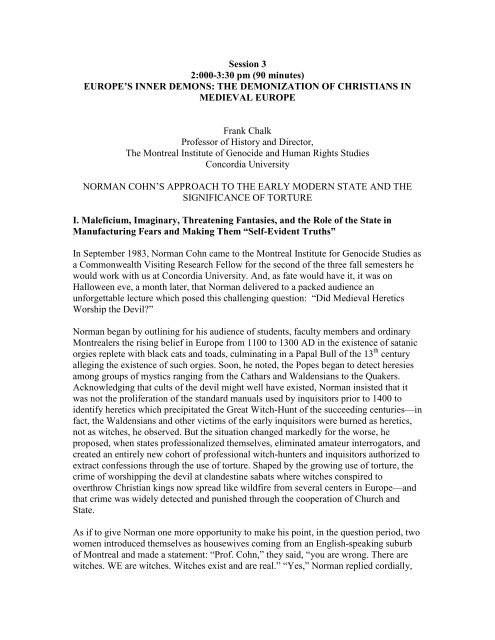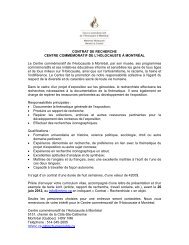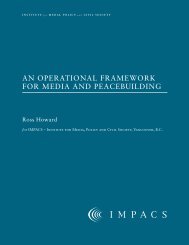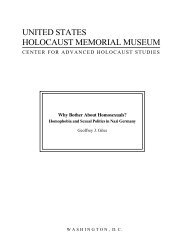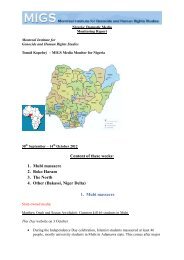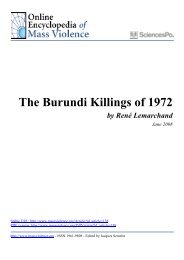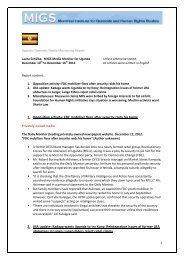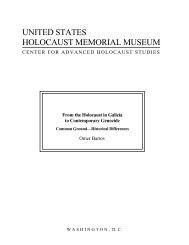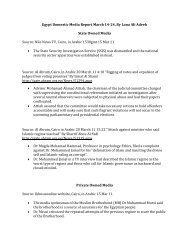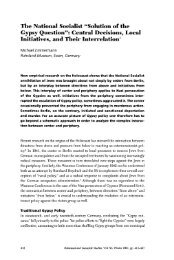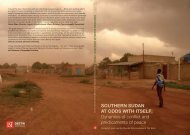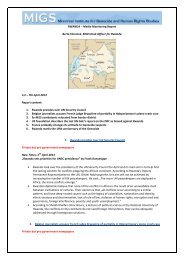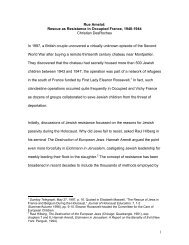Read - Montreal Institute of Genocide and Human Rights ...
Read - Montreal Institute of Genocide and Human Rights ...
Read - Montreal Institute of Genocide and Human Rights ...
You also want an ePaper? Increase the reach of your titles
YUMPU automatically turns print PDFs into web optimized ePapers that Google loves.
Session 3<br />
2:000-3:30 pm (90 minutes)<br />
EUROPE’S INNER DEMONS: THE DEMONIZATION OF CHRISTIANS IN<br />
MEDIEVAL EUROPE<br />
Frank Chalk<br />
Pr<strong>of</strong>essor <strong>of</strong> History <strong>and</strong> Director,<br />
The <strong>Montreal</strong> <strong>Institute</strong> <strong>of</strong> <strong>Genocide</strong> <strong>and</strong> <strong>Human</strong> <strong>Rights</strong> Studies<br />
Concordia University<br />
NORMAN COHN’S APPROACH TO THE EARLY MODERN STATE AND THE<br />
SIGNIFICANCE OF TORTURE<br />
I. Maleficium, Imaginary, Threatening Fantasies, <strong>and</strong> the Role <strong>of</strong> the State in<br />
Manufacturing Fears <strong>and</strong> Making Them “Self-Evident Truths”<br />
In September 1983, Norman Cohn came to the <strong>Montreal</strong> <strong>Institute</strong> for <strong>Genocide</strong> Studies as<br />
a Commonwealth Visiting Research Fellow for the second <strong>of</strong> the three fall semesters he<br />
would work with us at Concordia University. And, as fate would have it, it was on<br />
Halloween eve, a month later, that Norman delivered to a packed audience an<br />
unforgettable lecture which posed this challenging question: “Did Medieval Heretics<br />
Worship the Devil?”<br />
Norman began by outlining for his audience <strong>of</strong> students, faculty members <strong>and</strong> ordinary<br />
<strong>Montreal</strong>ers the rising belief in Europe from 1100 to 1300 AD in the existence <strong>of</strong> satanic<br />
orgies replete with black cats <strong>and</strong> toads, culminating in a Papal Bull <strong>of</strong> the 13 th century<br />
alleging the existence <strong>of</strong> such orgies. Soon, he noted, the Popes began to detect heresies<br />
among groups <strong>of</strong> mystics ranging from the Cathars <strong>and</strong> Waldensians to the Quakers.<br />
Acknowledging that cults <strong>of</strong> the devil might well have existed, Norman insisted that it<br />
was not the proliferation <strong>of</strong> the st<strong>and</strong>ard manuals used by inquisitors prior to 1400 to<br />
identify heretics which precipitated the Great Witch-Hunt <strong>of</strong> the succeeding centuries—in<br />
fact, the Waldensians <strong>and</strong> other victims <strong>of</strong> the early inquisitors were burned as heretics,<br />
not as witches, he observed. But the situation changed markedly for the worse, he<br />
proposed, when states pr<strong>of</strong>essionalized themselves, eliminated amateur interrogators, <strong>and</strong><br />
created an entirely new cohort <strong>of</strong> pr<strong>of</strong>essional witch-hunters <strong>and</strong> inquisitors authorized to<br />
extract confessions through the use <strong>of</strong> torture. Shaped by the growing use <strong>of</strong> torture, the<br />
crime <strong>of</strong> worshipping the devil at cl<strong>and</strong>estine sabats where witches conspired to<br />
overthrow Christian kings now spread like wildfire from several centers in Europe—<strong>and</strong><br />
that crime was widely detected <strong>and</strong> punished through the cooperation <strong>of</strong> Church <strong>and</strong><br />
State.<br />
As if to give Norman one more opportunity to make his point, in the question period, two<br />
women introduced themselves as housewives coming from an English-speaking suburb<br />
<strong>of</strong> <strong>Montreal</strong> <strong>and</strong> made a statement: “Pr<strong>of</strong>. Cohn,” they said, “you are wrong. There are<br />
witches. WE are witches. Witches exist <strong>and</strong> are real.” “Yes,” Norman replied cordially,
“witches like you do exist, but I am willing to wager that you did not fly here on your<br />
broomsticks or copulate with the Devil.” His key point—that at the heart <strong>of</strong> the Great<br />
Witch-Hunt lay the st<strong>and</strong>ardization <strong>and</strong> sanctification <strong>of</strong> a state-imposed consensus<br />
affirming the existence <strong>of</strong> conspiratorial <strong>and</strong> malign pacts between witches <strong>and</strong> the Devil<br />
to overthrow Christian kings—had found its local anti-type.<br />
Norman had made his point even more elegantly several years earlier in Europe’s Inner<br />
Demons, when he wrote:<br />
“The great witch-hunt can in fact be taken as a supreme example <strong>of</strong> a massive killing <strong>of</strong><br />
innocent people by a bureaucracy acting in accordance with beliefs which, unknown or<br />
rejected in earlier centuries, had come to be taken for granted, as self-evident truths. It<br />
illustrates vividly both the power <strong>of</strong> the human imagination to build up a stereotype <strong>and</strong><br />
its reluctance to question the validity <strong>of</strong> a stereotype once it is generally accepted.”<br />
While Norman wrestled with what processes had contributed to popular fears about the<br />
malicious acts <strong>of</strong> witches in league with the devil, he also recognized the important role<br />
played by states in manufacturing fear. In his postscript to Europe’s Inner Demons,<br />
Norman reminds readers that fantasies about the Christians <strong>of</strong> Lyon in the second century<br />
<strong>and</strong> the Knights Templar in the fourteenth were “cynically <strong>and</strong> consciously exploited to<br />
legitimate an exterminatory policy which had already been decided on.” In contrast, he<br />
notes, in the case <strong>of</strong> the Great Witch-Hunt, it could only have reached “massive<br />
dimensions where the minds <strong>of</strong> the authorities were obsessed by the central fantasy itself.<br />
The law was re-shaped to take account <strong>of</strong> it: in the form <strong>of</strong> the witches’ sabat it became<br />
the core <strong>of</strong> a new <strong>of</strong>fence . . . . And on the charge <strong>of</strong> that imaginary <strong>of</strong>fence, many<br />
thous<strong>and</strong>s <strong>of</strong> human beings were burned alive.” (p. 259)<br />
In her book Enemies <strong>of</strong> God, historical sociologist Christina Larner, who was influenced<br />
by Norman as he was influenced by her, concluded in 1981 that “the extermination <strong>of</strong><br />
thous<strong>and</strong>s <strong>of</strong> persons falsely accused <strong>of</strong> demonic witchcraft was part <strong>of</strong> a process by<br />
which the rulers <strong>of</strong> seventeenth-century Scotl<strong>and</strong> sought to impose the new notion <strong>of</strong> a<br />
nation-state upon a recalcitrant peasant population.” Larner contends that Scotl<strong>and</strong>’s<br />
rulers asserted the legitimacy <strong>of</strong> their new social order <strong>and</strong> compelled conformity <strong>and</strong><br />
loyalty to it by imposing Calvinist Christianity on a peasant population still far from<br />
Christianized <strong>and</strong> by inventing new mechanisms <strong>of</strong> social control to monitor peasant<br />
behavior, enforce orthodoxy <strong>and</strong> punish deviance.<br />
II. The Role <strong>of</strong> Torture<br />
Central to the annihilation <strong>of</strong> the Cathars <strong>and</strong> the Knights Templar was the role <strong>of</strong> statesanctioned<br />
<strong>and</strong> organized torture. With the growth <strong>of</strong> state-instituted judicial codes <strong>and</strong><br />
courts, confessions extracted under torture became crucial to demonizing <strong>and</strong><br />
confiscating the wealth <strong>of</strong> whole groups <strong>of</strong> people such as the Templars <strong>of</strong> France under<br />
King Philip the Fair. It was torture that forced confessions by Templars to such crimes as<br />
heresy <strong>and</strong> worshipping the Devil, practicing sodomy, <strong>and</strong> anointing idols with the fat <strong>of</strong><br />
roasted infants. In cases such as these, the monarch had already decided on an
exterminatory policy <strong>and</strong> he did not see torture as an instrument that could break the<br />
Devil’s grip, nor did he view the torture ordeal as a struggle between the forces <strong>of</strong> God<br />
<strong>and</strong> the forces <strong>of</strong> the Devil. Rather, when some Templars retracted their false confessions,<br />
Philip the Fair quite cynically labeled them as unrepentants <strong>and</strong> immediately condemned<br />
them to be burned at the stake.<br />
The work <strong>of</strong> Norman Cohn reminds us that torture is an odious instrument which<br />
ultimately backfires on those who employ it. It was the torturers, authorized by Church<br />
<strong>and</strong> State, who extracted the false testimony which distorted public underst<strong>and</strong>ing <strong>of</strong> the<br />
religious beliefs <strong>of</strong> the Cathars, justified their destruction, <strong>and</strong> sabotaged the Church’s<br />
chances <strong>of</strong> reforming itself centuries before Martin Luther appeared. It was the torturers<br />
who extracted more <strong>and</strong> more false accusations <strong>of</strong> flying on brooms to meetings with the<br />
Devil who were instrumental in the spread <strong>and</strong> duration <strong>of</strong> the Great Witch-Hunt. And<br />
centuries later, it was the torturers who provided the fodder for Stalin’s Great Purges,<br />
until they, too, were killed with a shot fired into the back <strong>of</strong> the neck. These observations<br />
about state sanction <strong>of</strong> torture are only a few <strong>of</strong> the insights developed by Norman in<br />
Europe’s Inner Demons.<br />
But perhaps the most important insight Norman left us, <strong>and</strong> perhaps his most encouraging<br />
legacy, comes at the end <strong>of</strong> Europe’s Inner Demons, in his Postscript. It concerns what<br />
we might call “The Cohn Paradox <strong>of</strong> Unexpected Research Outcomes.” As Norman<br />
stated it in outline:<br />
“What began as an enquiry into the origins <strong>of</strong> the great witch-hunt has led in some<br />
unexpected directions <strong>and</strong> has produced unexpected results. On the one h<strong>and</strong> various<br />
widely accepted notions have turned out to be baseless, while on the other h<strong>and</strong> various<br />
factors which have generally been overlooked have turned out to be <strong>of</strong> decisive<br />
importance. The story itself, I think, is now tolerably clear. But again <strong>and</strong> again I have<br />
felt that the fears <strong>and</strong> hatred which I was studying had origins <strong>and</strong> meanings which were<br />
unknown to those who were moved by them to torture <strong>and</strong> to kill.”<br />
That is an observation, I suggest, whose portent we would do well to ponder <strong>and</strong> study.<br />
* * * * *


